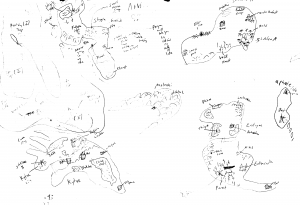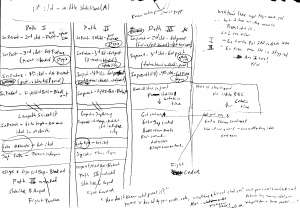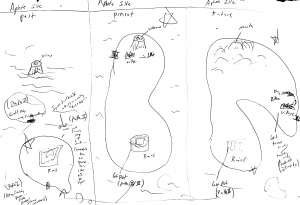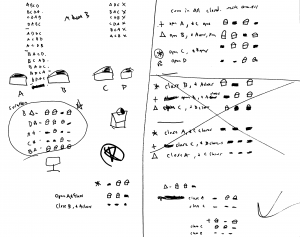This is continuing the series on Arvale Game Design from Part 1 here.
Welcome back! As promised, this time I’m going to spend a bit less time on the map designs themselves and a bit more time on other things such as designing the story outline, puzzles, the big problems with time/dimensional traveling, and even designs for the music and sound files. Don’t worry, you can still make fun of my terrible handwriting 🙂 We’ll be using examples from:
Arvale II: Ocean of Time
I should note that some thought actually went into the name of the game. While a few people made jabs about it being similar to Zelda: Ocarina of Time, that never once entered my mind (until the jabs, of course). The idea was to somehow combine that in Arvale II, you were now able to navigate across the entire overworld on a sea ship (something you couldn’t do in Arvale 1), and how the story had something to do with time travel. I thought Ocean of Time summed that up quite nicely.
This of course meant that we needed a coffee-stained, overall world map. While the scan doesn’t come out as great as I had hoped, you can still zoom in and make out most the lovely palm trees around ‘Stabilize A‘. This was quite early in the design, yet notice how most things already have names on the map. This is obviously in part due to many of the locations existed in Arvale 1. It is also nice to see how the continents are actually arrange on the world map now, since that wasn’t possible in the first game. It was even more fun to figure out how to arrange the extra continents needed for the story in Arvale: Short Tales and Arvale III. But that will have to wait until Part 3 of this series 😉
The seeds for Arvale II were already somewhat sown in Arvale: Journey of Illusion. You could see references to DeMenchev’s character as a prohpet in the Soneros Desert and great thinker of the past who invented a flying machine, in the town of Queous. I think he was mentioned in Invyl as well, I forget 🙂
The idea for DeMenchev was of course based on Leonardo DaVinci. But I thought it would be really interesting if DaVinci wasn’t actually an brainiac genius, but someone well-traveled, who studied and gained all of his knowledge about the world of Arvale by searching for lost artifacts and civilizations, which surely leads to the Indiana Jones influences.
Arvale II also gives the player an option on which path they would like to take (although a bit unwittingly, but that is by design of the story). Time travel is a bitch. Ask anyone who has done it. As far as story-telling goes, linear time travel is the only thing that is really entertaining. The game Chrono Trigger and the Back to the Future movies are great examples of this. But intellectually and scientifically it’s kinda boring and overdone (you can’t go back in time and kill your own grandfather, there I said it). So opening up the ideas of quantum time travel or dimensional travel seemed like a fun idea. Chrono Cross touched on this and was a great game, but not quite as entertaining as Chrono Trigger, maybe I should have learned their lesson? 🙂
Ironically, the latest Indiana Jones film touched on dimensional travel too (maybe they were playing Arvale?). Anyway, I opted for something in-between mixing linear time travel (the time pieces) and jumbling up different dimensions (the stabilizer idols), and well, it’s unique.
The outline above tries to make sense of the three main paths (and two resulting semi-optional paths) the player can choose and the major events which will happen in the story. Such as: which temple the player will go to, what time period he will be in, and how the character will have to travel to the next temple in that time period. Which brings me to another problem with time travel: Maps.
The Arvale II marketing texts says the game contains over 325 maps (at my advice) which was a vast understatement looking back on it. Because many of the maps in the game needed to be multiplied by 3. I had to recreate many of the maps in each time period (Past, Present, and Future) to adjust the continents for what might happen to it over time (the Volcano on Aphote island, the River/Lake on Stygia, etc). This also means that all of the event triggers had to be recreated and check for where the player was at any time during the game. Since there are very few global flags in Arvale (integer values that keep track of everything in the game, no matter what), this was very tricky to accomplish. Even trickier to take the player from a Past Overworld map into a Dungeon (the only maps which were global and had no time status) and have them Exit the dungeon and still end up in the Past.
I wanted to add more puzzle-type things into Arvale II. Given the relatively limited engine, it took a lot of creativity to come up with puzzles bigger than: flip switch, open door. One of the first puzzles in the game was a spin-off of what I think was an old puzzle in Final Fantasy VI for Super Nintendo. This picture looks way more confusing that the original puzzle it was made for. It had to be setup using a triggers for each open/close of the chest, change the state of the other chests, and set a flag to 1 or 0 each time that was done (just in case, and to keep track of it). During the design of the puzzle, I was reminded of a lot of homework which I never thought would be important when I was in 7th grade. 🙂
A much neater puzzle was near the end of the game, in the final dungeon (I think). It had to do with redirecting a light source from the ceiling to hit a fountain in another room by using mirrors and moving blocks and stuff. Alas, I couldn’t find the documents for that one 🙁
I wanted a lot more music in Arvale II than in Arvale:JOI. But given the restrictions of the original platform, Windows Mobile, we had to make the music fit in a really small file size (and take up minimum processor usage). We were already using XM Fast Tracker II format, which is small and manageable for a few songs. However, XM files not only contain the note information (like a Midi file) but also contain all the samples for any instruments the song uses as well.
For example: if you have your first song with Strings, Horns, and Timpani, and a second song which has a Drum Kit, Distorted Guitar and Voices, they will have completely separate samples embedded into their files. But, if you write a third song which has Strings, Guitar, and a Drum kit, it might also have the same samples as the first two songs and you would be wasting space.
An XM file has a length advantage/disadvantage of being able to squeeze about 3-4 songs into one file (music writers: it is limited to 256 patterns, similar to musical measures, which can be divided by 64, and adjusted by tempo to whatever subdivision you wish). With that in mind, I decided I could arrange the music so that songs with similar instrumentation could go into the same files.
On the above page, on the left side, you can see all of the music pieces (with the slashes) and the instruments I planned on using in their arrangements. On the right side, I divided out which actual files they would end up being shared into. I believe the game ended up with 8 total XM tracks with a total of 27 music tracks. With around 65 minutes of total music. The total uncompressed file size was less than 1.5 MB. Not bad for a Windows Mobile game 🙂
That’s it for Part 2. I hope that enlighted you or entertained you a bit on puzzles, music, outlines, and time travel 🙂
In Part 3, I’ll use examples from Arvale: Short Tales and touch on topics such as Quest Design, Semi-Persistent worlds, more Maps, and perhaps even a few bits of information on Arvale: III 🙂 If you have any other requests, leave something in the comments and I’ll do my best to fit it in the next installment.
Continue reading onto Arvale Game Designs on Paper, Part 3.






